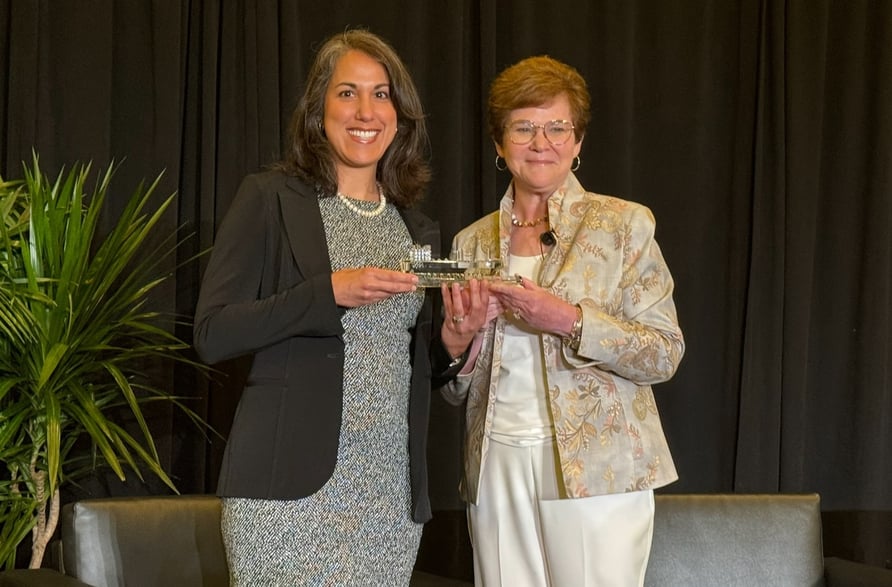HIGHLIGHTS: APRIL 19, 2024
• Dairy nourishes the world
• A look at opportunities in Latin America
• Maintaining a China presence
• USDEC launches new U.S. dairy export awards; Durkin honored
• Member input wanted on cargo pilferage
• USDA announces new funding for food aid
• New GSP legislation addresses common name challenge
• Ag coalition calls for more aggressive U.S. trade agenda
• Letter seeks full funding for U.S. Codex Office
• Market Summary: USDEC Econ team splits on 2024 export growth expectations
• GDT holds steady
• Ford makes Time’s 2024 “influential people” list
• Fonterra shutters production lines
• Company briefs: Westland Milk Products, Emmi, Valio, Superbrewed Foods
Featured
Dairy as a necessity for nourishing the world
USDEC and the U.S. industry have spent more than 25 years growing U.S. dairy trade to the point where it is no longer just a “stepchild” to the domestic market, USDEC President and CEO Krysta Harden noted in her opening remarks at this week’s Annual Membership Meeting in Houston. While U.S. dairy will always be domestically driven, exports these days are recognized as not only essential to the industry’s overall health but also to address the growing challenge of sustainably nourishing the world.
That recognition has opened a door for U.S. dairy. USDEC is working hand-in-hand with dairy farmers, dairy processors, importers, distributors, retailers, foodservice operators and policymakers in key markets to build partnerships to cultivate dairy demand and trade. The aim is to create a scenario that delivers sustainable nourishment to countries that lack an abundance of dairy in their diets while simultaneously creating mutually beneficial growth for the dairy sectors on all sides. It’s an all-win scenario.
USDEC staff is working to engage with these markets to help them “grow demand, understand the value of dairy and trust the U.S. as the supplier of choice to help augment and complement what they're doing in their countries,” Harden said.
Bringing U.S. dairy together
Similarly, USDEC itself is an organization that aims for mutually beneficial growth in all sectors of the U.S. dairy industry. Harden said farmer support has been and will continue to be critical to all USDEC works. (“None of us would be doing what we do without them,” she said.)
But USDEC’s strength comes from its uniqueness in bringing together all the stakeholders in the industry: farmers, processors, traders and allied companies.
“We try to make sure there's a place for everyone, that there is a voice for you at our table in decision-making processes, and that we know that we're all linked together, that we do this together for all the good,” said Harden.
Meeting focus
Harden outlined three areas that speakers at the Annual Membership Meeting would highlight repeatedly over the course of the day: China, emerging markets in Latin America and Africa, and USDEC on the global stage. (See below for further coverage of Latin America and China.)
Despite geopolitical tensions, she said, China is a nation where “we still can do business … People still need nourishment.”
With Latin America, “we need to work closer together. We share so many different common issues and challenges.”
Because of that commonality, the U.S. already works well geopolitically with Latin America at platforms like the UN Food and Agriculture Organization (FAO), she said. And there are opportunities for untapped partnerships in dairy in Mexico, Central and South America, and the Caribbean.
USDEC’s global presence—in China and Latin America, but also Southeast Asia, the Middle East/North Africa, Japan, South Korea and Taiwan—was a theme throughout the day. Relationships are the bedrock of global trade. The U.S. dairy sector must be present in the markets in which it sells. Traveling to those markets, meeting farmers, buyers and policymakers, and developing bonds is key to USDEC’s work.
“We’re always on the road and all of you are as well,” said Harden. “Just about everywhere I go, I'm bumping into some of you or your folks in that country … I think what's so unique about the U.S. is that we do like to go, we do understand the value of relationships, of that trust and that respect.”
USDEC will post video and slides from the Annual Membership Meeting in the coming weeks. Stay tuned to Global Dairy eBrief for more information.
Latin American opportunities strong
Three separate sessions at this week’s Annual Membership Meeting focused specifically on opportunities in Latin America and what U.S. suppliers could do to grow business in the region. Expert speakers from across the Americas included Luz Maria de la Mora, Mexico’s former vice minister; Edgar Vasquez, former Peruvian Minister of Trade; René Sanchez, marketing manager, Suministros y Alimentos; Aura Hernández, purchasing manager, Centurion Foods; Emilio Ho, CEO of Grupo Chela; Rodrigo Fernandez, chief of USDEC’s Mexico and Central America office; and Monica Ganley, USDEC senior director, Global Trade Analysis, who is based in Argentina. All agreed the opportunities are encouraging for U.S. dairy suppliers.
Across the entire region, when the economy grows, dairy demand grows, said Fernandez. And the economy at present is on a growth streak.
De la Mora said we are seeing a “Mexico moment” right now in her country. The Mexican economy had one of its strongest years ever in 2023, unemployment is at a record low, inflation is falling, wages and private consumption are rising and expected to keep growing. Mexico is hot because it is seen as “the ideal partner” to the U.S., particularly given the China trade war.

Krysta Harden moderated the session “A View from Latin America: A Political and Market Perspective,” featuring former Peru Minister of Trade Edgar Vasquez, and former Mexico Vice Minister Luz Maria de la Mora.
And Mexico isn’t alone. Nearly all countries in Central America are outpacing the world in economic growth terms. In addition, dairy tariff phaseouts in the Dominican Republic-Central American Free Trade Agreement (CAFTA-DR) are winding down, setting the stage for improved U.S. dairy market access to the region. And only one country (Costa Rica) currently exceeds per capita dairy recommendations set by the FAO.
Vasquez called South America “still a land of opportunity,” with deep natural resources and young and improving economies.
Fitting the product with the market
None of this is to say U.S. dairy export growth to Latin America will be easy. Ganley noted one directive for South America that applies to the region as a whole: It is not one homogenous place. There are enormous differences within regions and even within countries themselves.
In Brazil, the biggest current opportunity is in high-protein whey; in Chile, gouda presents one of the best options for U.S. suppliers; Colombia is an emerging market for milk powder and cheese.
“The key to maximizing opportunity will be determining the best products for each market and working to develop the market in a consistent way,” said Ganley.
That includes being a consistent presence in the actual market—visiting regularly to observe and meet face-to-face with buyers and customers. In-person, in-market meetings were one of the critical recommendations voiced by virtually every speaker.
“See the region as a partner,” said Fernandez. Work with manufacturers, work with the foodservice sector, to help them learn how to use dairy ingredients and cheese and how they might align with the local diet.

Will Loux discussed, “Exploring the Emerging Opportunities and Challenges in South and Central America,” with Monica Ganley and Rodrigo Fernandez.
“Look for partners that are developing the market,” said Sanchez. They want input and ideas and are looking for long-term growth opportunities.
Innovation assistance is another key. Ho said the Panama dairy sector needs more creativity and technology, and the U.S. could be a partner in providing that.
Partnerships can also help overcome pricing challenges. Latin America in general is a price-sensitive market, said Hernández. Customers want quality at affordable prices.
Promotions can help overcome pricing hesitance, she suggested. An initial discount can help earn trial and win over shoppers in the long run.
Ho is a strong believer in sampling and suggested creating “roadshows” to attract consumers, where presenters can talk about products and offer tastings.

Left to right: USDEC’s Angélique Hollister, Aura Hernández, Centurion Foods; René Sanchez, Suministros y Alimentos; Emilio Ho, Grupo Chela; and USDEC’s Rodrigo Fernandez.
Additional challenges
Latin America is not free of trade barriers, and there are always factions who feel dairy imports run counter to their own vested interests. USDEC proactively works to address barriers to dairy trade every day, including strongly emphasizing compliance with existing trade deals with Mexico, the CAFTA-DR partners and Colombia.
Just as it is critical to maintain in-person contact with buyers, Vasquez highlighted the importance of doing the same with governments in the region. Face-to-face meetings are “very important”—government-to-government and private sector-to-government.
De la Mora conceded that we are seeing a backlash to trade in some Latin American markets right now, including Mexico. “The U.S. dairy industry has to have a clear message,” she said. “You are an important partner to the region because you complement the domestic industry.”
The U.S. needs to have a presence in Mexico and meet face-to-face with business and government. She recommended the U.S. dairy industry remind people in Mexico of the Mexican dairy growth story and back that with facts and numbers—how both countries are expanding and how that is creating opportunities.
Castaneda on China: “We need to be present. We need to be there.”
Despite current challenges in the geopolitical landscape with China, there remains a promising opportunity to expand U.S. dairy exports to this significant market.
At USDEC's Annual Membership Meeting, Executive Vice President of Policy Development and Strategy Jaime Castaneda emphasized the importance of maintaining a strong presence in China to build lasting relationships and drive positive impact.
With a population of 1.4 billion, China stands as the world's second-most populous country, offering vast potential for U.S. dairy exports. Although projections indicate a decline in China's population in the future, a notable demographic shift is expected with a larger segment of the population over 60.
This demographic shift presents not a crisis but an opportunity for increased prosperity and purchasing power among the Chinese population. As the middle class expands in China, there is a rising interest in dairy products, particularly cheese, as evidenced by the growing popularity of items like pizza among young people.
USDEC remains dedicated to cultivating demand for U.S. dairy exports in China through various strategic initiatives. In late June, USDEC staff and member companies will engage in a trade and fact-finding mission to China in collaboration with the USDA Foreign Agricultural Service. This mission will involve one-on-one commercial meetings in Shanghai and Beijing to strengthen relationships and foster growth in the Chinese market.
At Tuesday’s meeting, USDEC members received a video message from Madam Yu Lu, vice president of The China Chamber of Commerce of Import & Export of Foodstuffs, Native Produce & Animal By-Products (CFNA), highlighting areas of collaboration with USDEC and the U.S. dairy industry.
Many of the USDEC member companies in the audience could agree with Castaneda and Madam Yu Lu that a consistent and persistent presence in the Chinese market is key to making a meaningful difference and seizing the opportunities that lie ahead.
USDEC rolls out new export awards program; Durkin earns lifetime achievement honor
USDEC launched a new annual export awards program at this week’s Membership Meeting. The Excellence in Exports Awards (also known as the ExEx Awards) will be given annually to recognize companies and individuals who go above and beyond to grow U.S. dairy business in international markets.
USDEC will present the first full slate of ExEx award winners at the 2025 Membership Meeting at the Willard Intercontinental in Washington, D.C., April 7-9. But President and CEO Krysta Harden laid the foundation on Tuesday by bestowing the very first—a Lifetime Achievement Award—to Mike Durkin, president of Leprino Foods. Durkin earned the honor for his “unwavering commitment and visionary leadership in advancing American dairy on the global stage.”
Among his many accomplishments, Harden pointed specifically to Durkin’s work during the supply chain crisis.
“He came to Washington multiple times to testify. He participated in many roundtables at the White House and with the Department of Transportation, with shipping lines and with other groups. He was a spokesperson for the industry,” Harden said.
“He would come when he probably didn't have the time to come, but he made such an effort. He said, ‘Somebody has got to do this,’ and Mike did. … I’m sure that not losing market share was very important to him and Leprino, but more importantly, he was making sure the U.S. maintained the reputation as a reliable, trustworthy dairy supplier that he had helped build.”
Family affairs prevented Durkin from attending this year’s meeting, but Adela Ramos, Leprino Foods’ director, regulatory affairs, accepted the award in his absence.
USDEC will provide more information on the awards—including categories and criteria—in the coming months.

Adela Ramos accepts the new USDEC Excellence in Exports Lifetime Achievement Award from USDEC’s Krysta Harden on behalf Leprino Foods’ President Mike Durkin.
Member input wanted on intermodal cargo pilferage
Cargo theft is on the rise in the U.S. and dairy export shipments are not immune. USDEC is working to determine the scope of the problem and seek solutions to intermodal container break-ins. The Trade Policy team has reached out to the Surface Transportation Board, the FBI and railroads and secured Congressional appropriations report language directing Homeland Security to report on the issue. While staff has spoken to some members who have victims of theft, additional member input is needed. To help USDEC resolve the issue, please contact Tony Rice at trice@usdec.org with information about any recent cargo pilferage incidents you have experienced.
Trade Policy
New GSP legislation makes progress on defending common food and beverage names
The House Ways and Means Committee marked up a bill to renew the Generalized Systems of Preferences (GSP) trade program but with new agriculture-specific eligibility criteria that will help U.S. suppliers compete on a level playing field in GSP markets.
The GSP trade program, which has not been in effect since it expired at the end of 2020, helps developing countries use trade to grow their economies by eliminating U.S. duties for a range of products. GSP-eligible countries must meet certain conditions to participate.
The bill includes new provisions for the agriculture industry, including requirements that beneficiary countries provide open and equitable market access to U.S. agriculture exports and protect the generic use of common food and beverage terms like “parmesan” and “feta.” USDEC and NMPF provided input on the legislation, which counters the EU’s ongoing offensive to monopolize common name foods and beverages by imposing overreaching geographical indication policies on countries worldwide.
“The U.S. government has the political and economic influence to fight back,” said Jaime Castaneda, USDEC executive vice president, policy development and strategy, in a joint press release from USDEC, NMPF and the Consortium for Common Food Names. “We’re pleased to see that Congress is starting to utilize the tools at its disposal to secure producers’ common names rights.”
Ag coalition reiterates calls for more aggressive U.S. trade agenda
A coalition of 33 U.S. ag associations, including USDEC and NMPF, sent a joint letter to USTR Katherine Tai urging the administration to recommit to an aggressive trade agenda to meaningfully expand export opportunities for U.S. food and agricultural products ahead of a House Ways and Means Committee trade oversight hearing on April 16. The letter echoes a series of February letters sent by House members, the Ag Trade Caucus and U.S. ag groups calling for action to boost U.S. agricultural trade competitiveness (see Global Dairy eBrief, 3/1/24).
The latest coalition letter suggests several steps to improve opportunities for U.S. dairy and ag suppliers, including:
- Pursuing comprehensive trade agreements that eliminate tariff and non-tariff barriers to help ensure that U.S. agriculture can compete on an even playing field in our export markets.
- Making sure both sides, including the U.S., abide by their WTO and other trade commitments. U.S. actions that conflict with trade obligations have precipitated retaliatory tariffs that have caused significant long-term economic harm and market disruption for U.S. agricultural producers, the letter states.
- Actively enforcing trade rules to ensure U.S. farmers capture the full scope of market access benefits within our existing trade agreements.
- Pressing international trading partners to implement objective science and risk-based regulatory measures—and ensuring they uphold those obligations when threatened.
- Completing negotiations for WTO dispute settlement system reform in 2024, as it has already committed
“The success of U.S. agriculture depends on a rules-based system of trade, including enforcement mechanisms designed to protect U.S. agriculture from trade distorting impacts by trading partners’ non-compliance,” the letter concludes.
USDEC urges full funding for U.S. Codex Office
A coalition of 45 agricultural groups, including USDEC and NMPF, co-signed a letter to the chair and ranking member of the Senate and House Committees on Appropriations urging full funding for the U.S. Codex Office (USCO) in the fiscal 2025 Agriculture-FDA Appropriations bill.
The USCO is a valued voice in countless multilateral institutions, including the WTO and the Codex Alimentarius Commission. It plays an instrumental role in advocating for and developing science and risk-based food standards on behalf of farmers, ranchers, and the food industry to protect the health of consumers and ensure fair practices in the food trade worldwide.
The letter asks for funding levels at or above the fiscal 2024 amount of $4.9 million.
An underfunded USCO would “hamper our nation’s ability to engage on critical multilateral issues that affect all Americans as well as the greater global population,” the letter states. “It is imperative the USCO receives full and adequate funding for FY 2025.”
USDA, USAID announce new food aid pilot project
USDA and the U.S. Agency for International Development (USAID) announced $1 billion in Commodity Credit Corp. (CCC) funding to purchase U.S. grown commodities to provide emergency food assistance to people in need globally. While the bulk of those funds will be dedicated to crops that align with traditional USAID international food assistance programming, $50 million of the initial tranche is earmarked for a pilot program for nontraditional foods that are shelf-stable and suitable for use in feeding food-insecure populations.
USAID is working with humanitarian organizations to develop this limited pilot project. Details will be released once they have been developed. This pilot will only apply to this funding stream and no other food assistance programs administered by USAID.
The announcement follows USDEC and NMPF’s advocacy for increased flexibility for U.S. dairy to contribute to global nutrition needs (see Global Dairy eBrief, 4/5/24). USDEC will continue to work with USDA partners to determine how U.S. dairy can more significantly contribute to global nutrition efforts.
Market Summary
USDEC Econ team split on export growth for 2024; members upbeat
At the Global Market Outlook presentation at the Annual Membership Meeting, two of three USDEC Economics team members said they believe U.S. dairy export growth would return to trend in 2024, with milk solids equivalent volume rising more than 1.6%. USDEC members broke similarly to the Econ team, with 71% expecting growth to top 1.6%.
Improvements in the global economy, while differing from region to region, should be sufficient to lift dairy consumption and U.S. export volume, said Stephen Cain, USDEC senior director, Economic Research and Analysis. However, some major buyers are likely to lag, including China, where the Econ team sees imports largely moving sideways this year.
Will Loux, senior vice president, Global Economic Affairs; Monica Ganley, senior director, Global Trade Analysis; and Cain offered a series of over/under projections for U.S. dairy export stats for 2024 during the Market Outlook presentation, inviting members to offer their expectations on each via the app Slido (which immediately calculates audience response). In addition to the overall U.S. dairy trade projection, the majority of the group expects:
- Cheese sales growth to Mexico to slow to less than +10% (all three panelists expect U.S. cheese shipments to Mexico to grow in 2024, but Ganley pointed to expectations for a slightly weaker peso and Cain saw a plateau after two rapid years of strong gains, with growth ultimately below 10%).
- Cheese sales to South Korea to move back into growth mode (U.S. shipments to Korea fell 40% in 2023).
- Chinese WMP imports to rise less than 12% (questions on Chinese economic growth remain unanswered, Cain noted, while Loux added the question of whether we might be starting to see a fundamental shift lower in Chinese WMP demand long term given increased domestic milk and dairy production).
- Low-protein whey sales to Southeast Asia to increase less than 8% (while the market is coming back after a down year, getting back to trend might be a challenge, said Loux).
- Brazilian WPC80+ demand to rise again in 2024 (growth in Brazilian whey-protein beverages has come even with poor economic growth, said Ganley, so as the economy improves in 2024, there’s no reason to expect consumption—and imports—to decline).
- Middle East/North Africa (MENA) SMP purchasing to drop by more than 4% (Algeria boosted NFDM/SMP trade in 2023, but is an inconsistent buyer; in addition, Sub-Saharan African demand for fat-filled milk powders is lagging, lowering NFDM/SMP needs by MENA fat-filled powder blending operations).

Will Loux, Monica Ganley and Stephen Cain offering their over and under predictions at the Global Market Outlook session.
GDT holds steady
The Global Dairy Trade (GDT) Price Index took a breather at the April 16 auction, rising just 0.1%—a disappointing result after the healthy gain in the previous event, GDT Pulse results between auctions and NZX SGX indicators heading into the auction.
This week’s results make the 2.8% Price Index increase at the April 2 auction feel more like opportunistic buying after two declines in March, rather than the first step in an extended bull run. But there were other extenuating circumstances weighing on prices this week as well, including Middle Eastern buyers stepping back (perhaps due to growing geopolitical uncertainty in the region), fewer Chinese buyers and Fonterra reducing forecast WMP volumes by 12,133 MT over the next 12 months.
Overall, markets appear fairly balanced, with muted demand and limited supply growth. The average winning WMP price increased 0.4% to US$3,269/MT. SMP was down US$9.00/MT to $2,541/MT. While North Asia (China) was the top milk powder buyer, its WMP and SMP purchases each declined compared to the previous auction.
Butter fell 1.4% to US$6,546/MT, with the Middle East dialing back its purchasing. Despite the decline, butter have been remarkably stable for the past six auctions, trading in the fairly tight range of US$6,408/MT-US$6,592/MT. AMF ran its growth streak to 16 consecutive auctions dating back to Aug. 15, 2023, as prices rose 1.7% to US$7,062/MT.
Cheddar prices have alternated gains and losses for six straight auctions—up-down, up-down, up-down. This week, prices plunged 8.5% to US$3,974/MT even though volume sold topped both the last auction and the same event the previous year. Southeast Asia/Oceania was the biggest purchaser, followed by North Asia and Europe.
Company News
Ford makes Time’s “influential people” list
Beth Ford, CEO of USDEC member Land O’Lakes, was named to Time’s list of the “100 Most Influential People of 2024.” Time cites Fords work “at the forefront of a national effort to invest in America’s rural communities, from wider broadband coverage, to helping farmers adapt to the changing climate, to stronger trade efforts and more funding for agricultural R&D.” Click here to go directly to Ford’s entry.
Fonterra announces plans to close two Waikato dairy plants
In a move designed to shift resources toward high-value products, New Zealand dairy cooperative Fonterra said it will close two of its dairy processing plants in its manufacturing sites in Waikato. A Fonterra official cited aging assets and declining productivity for the closures of Waitoa PDC (specialty powders) and the site’s coal center, along with two dryers at Te Rapa.
The impacted operations will close near the end of this year. Efforts are being made to redistribute affected employees at the site, and Fonterra’s specialty nutrition dryer and UHT plants at Waitoa will continue to operate. Previous reports have indicated competition for milk is heating up in the Waikato region with the arrival of Olam Food Ingredients, a Singapore-based agricultural company that has been targeting Fonterra dairy farmers for supply. (Waikato Times, 4/11/24)
Westland Milk Products posts record profit
New Zealand’s Westland Milk Products reported a profit of NZ$56 million (about US$33 million) in 2023. The company attributed the record profit to strong sales of high-value dairy products like butter.
Westland CEO Richard Wyeth said the company’s backing from China’s Yili Group has enabled Westland to invest in infrastructure that will maximize revenue from high-margin products, including a new lactoferrin plant at the company's Hokitika plant. That development is expected to reduce reliance on traditional high-margin revenue sources like infant formula for China (as import demand in that sector softens).
Wyeth also said the company’s Hokitika butter plant has allowed the company to expand strongly by providing Westland-produced butter to Walmart stores in the U.S, and Costco stores in the U.S., Korea, Taiwan and New Zealand, with more international regions planned. He added that the company will continue to divert more milk solids into higher-value products in 2024. (Company reports)
Mergers, acquisitions and joint ventures
Laticínios Porto Alegre, the Brazilian subsidiary of Emmi Group, will acquire a majority stake in the Verde Campo dairy, a Coca-Cola-owned manufacturer of dairy products, including yogurt and milk drinks made with whey protein. A statement from Emmi said the deal will allow Emmi to consolidate and improve its position in the Brazilian market while “reinforcing the value of our portfolio with a strong brand and a focus on functional premium dairy products.” … As part of its strategy to acquire businesses to grow its Better Nutrition platforms, Ireland-based nutrition firm Glanbia entered an agreement to acquire California-based natural and organic flavor maker Flavor Producers from Aroma Holding for an initial consideration of $300 million. The transaction is expected to close in the first half of FY 2024. Flavor Producers will operate under Glanbia Nutritionals. (Company reports; Food Manufacture, 4/15/24)
Company briefs
Finland-based Valio said it will close two of its Finnish food and drinks manufacturing facilities and transfer those operations to its Riihimäki plant, which currently processes fresh dairy products and Valio’s Oddlygood brand of plant-based snacks. The company said that shutting the two sites would “improve production efficiency and profitability.” The closures are expected to occur no sooner than the first half of 2026. … U.S. biomass fermentation start-up Superbrewed Food said it has sold its Minnesota manufacturing facility and is looking for a larger site. The company, which recently formalized its manufacturing partnership with German ingredients giant Döhler, said the scale of production of its initial commercial volumes will exceed the capacity of its existing site. (Just Drinks, 4/9/24; FoodBev Media, 4/15/24)
In Case You Missed It...
U.S. Dairy Exporter Blog
Market analysis, research and news subscribe hereUSDEC Twitter feed
Follow us here.